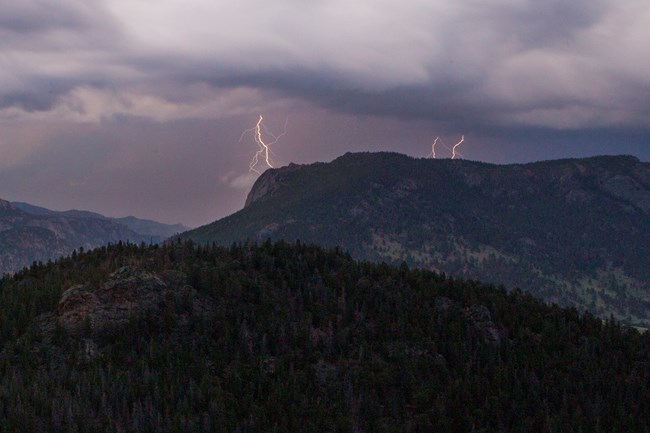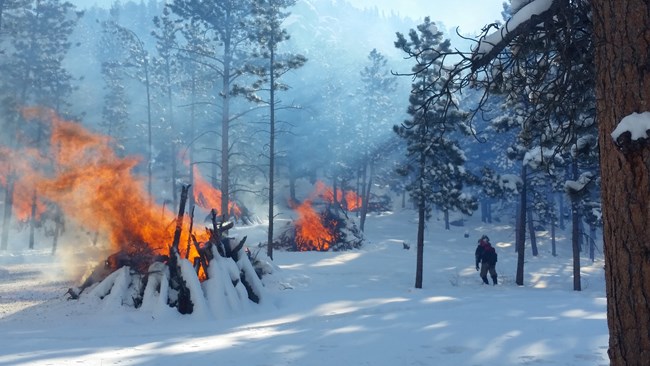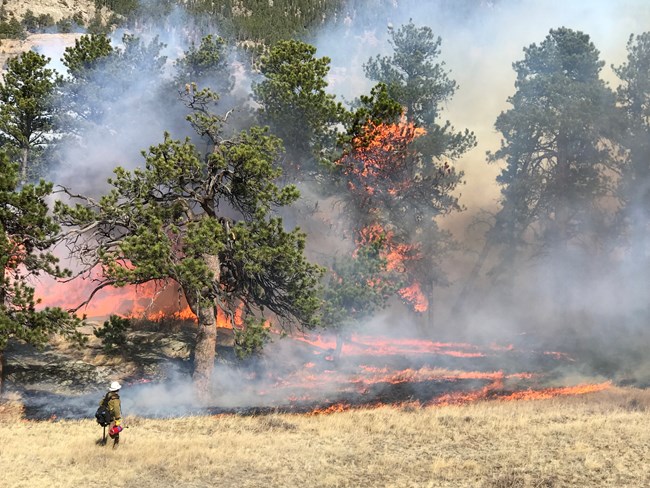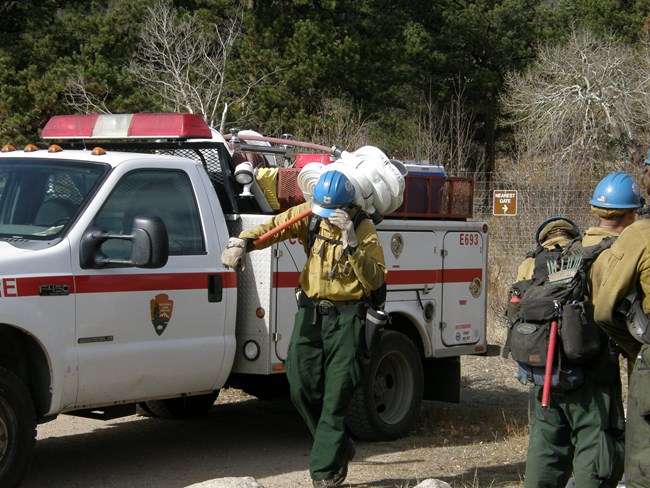
NPS Photo / Ann Schonlau What causes wildland fires?There are many reasons a wildland fire may start. Fire only needs three ingredients to ignite: oxygen, fuel, and heat. With oxygen in our air and plenty of fuel in our forests, Rocky is always just one heat source away from wildland fire. A common natural cause of wildland fire is lightning. With frequent afternoon thunderstorms in Rocky, lightning starts multiple fires inside the park each year. Humans also cause wildland fires. Unattended campfires, campfires that have not been properly extinguished, improperly disposed of cigarettes and matches, equipment misuse or malfunction, and escaped prescribed fires are all ways people can start wildland fires. Before visiting Rocky, it is important to learn some basic fire safety tips. Why is fire important to Rocky Mountain National Park?Fire is a natural and necessary ecological process that has been occurring here for thousands of years. Many plants and animals in this area depend on fire because it renews the landscape. When periodic fires come through, the old vegetation dies and is replaced by new vegetation. Without fire, old vegetation can build up and crowd the space, making it difficult for new life to find its way. What is a wildland-urban interface?A wildland-urban interface (WUI) is the area where homes and communities meet wildland fire-prone natural areas. Living in wildland-urban interfaces – like Estes Park, Grand Lake, and other communities near Rocky Mountain National Park – means fire-preparedness should be a top priority for your household. Fire in this region is inevitable, and strengthening your home’s defenses against fire is necessary for your safety and the safety of your community. 
NPS Photo What are the piles of wood we see inside the park?The piles of wood you may see as you spend time in Rocky are a part of the Fire Management team’s comprehensive fuels program. The goal of this program is to reduce heavy fuel loads – high amounts of flammable materials – from the forests near infrastructure and highly visited areas to increase safety for visitors and employees. Cutting dead and downed trees, piling the materials, and burning the piles is an efficient way to reduce the hazards of high fuel loads within the park. These burns are done in the winter months when the weather is safest for fire and visitation to the park is at its lowest. 
What is a prescribed fire?A prescribed fire – also called a “prescribed burn” or “controlled burn” – is the intentional ignition of fire by fire managers. Prescribed fires are an important tool used to reach certain management objectives under their fuels program. In Rocky, these planned burns are used to reduce the number of fuels in areas of the park close to infrastructure, with high visitation, and surrounding communities. Before starting a prescribed fire, managers carefully consider the safety of the public and fire staff, weather, and the probability of meeting the burn objectives. Will smoke from wildland fires or prescribed fires harm me?With wildland fire and prescribed burns, smoke in the air is inevitable. Smoke is made up of a mixture of gases and small particles, both of which can cause physical discomfort or more serious disorders. Eye and respiratory tract irritation are common effects of smoke, while reduced lung function and aggravation of chronic heart and lung diseases are more serious impacts. Those at highest risk are people with heart or lung diseases, children, pregnant women, and elderly people.
The health impacts of wildland fire are typically much higher than prescribed burns. Wildland fires can last days or weeks, while prescribed burns are usually short-term and low intensity.
The Colorado Department of Public Health & Environment provides tips for protecting yourself from smoke. 
NPS Photo How do you manage fires once they are started?Some fires will be put out while others may be allowed to burn. Fire managers assess the cause and location of a wildland fire in addition to the terrain, weather, and other important factors. They use these indicators to determine what action will help them to best meet their management goals.
Fires may be extinguished if putting them out reduces the risk of danger to park employees, the public, communities, infrastructure, or important natural and cultural resources. Rocky has a large wildland-urban interface (WUI), meaning much of the park borders residential areas. Fire managers carefully consider the WUI when making management decisions. However, it is important to realize that living in a WUI means fire near your home is inevitable and fire preparedness should be a top priority in your household.
While some fires are put out to achieve management goals, others may be allowed to burn if they are not threatening to people, communities, or important park resources. The management of naturally ignited fires – wildland fire use – is one way fire managers help maintain fire-adapted ecosystems. What is a Red Flag Warning?The National Weather Service gives a Red Flag Warning when warm temperatures, low humidity, and strong winds are expected to increase the risk of fire. If a Red Flag Warning is in place the Park may decide to enforce stricter fire regulations. It is critical that each individual knows and obeys fire rules and regulations at all times. Visit the National Weather Service’s RMNP Weather Decision Support page to learn more about current weather conditions in Rocky, including fire weather. How do I protect my home from a wildland fire?You can reduce the risk of wildland fire impacts on your home through careful planning and preparation. How can I report a fire in RMNP?To report a fire in the park, please call 9-1-1. Where can I find updates about fire in the park?Keep up with Rocky’s news releases, visit the National Weather Service’s fire weather page for RMNP, or call our information office at (970) 586-1206 to learn more about current fires inside the park and updates about fire restrictions. |
Last updated: January 15, 2025
